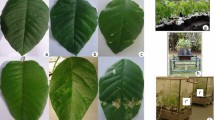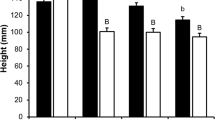Abstract
Aldehydes play an important role in atmospheric chemistry and plant direct and indirect defense against environmental stresses. In this study, the emissions of saturated C6–C10 aldehydes from Populus simonii × P. pyramidalis ‘Opera 8277’ cuttings were examined by using a gas chromatography/mass spectrometry (GC/MS) technique at three levels of light intensity (400, 800 and 1 200 μmol·m−2·s−1). A positive correlation between the emissions of these aldehydes and light intensity was found. Moreover, nordi-hydroguaiaretic acid (NDGA), a special inhibitor of lipoxygenase (LOX), significantly inhibited the emissions of C6–C9 aldehydes at three levels of light intensity, but did not influence the emission of decanal (C10). The emissions of C6–C10 aldehydes in NDGA treated poplar cuttings, exhibited the same positive correlation with light intensity. The results indicated that LOX pathway contributes to the emissions of C6–C9 aldehydes, whereas some pathways regulated by light intensity might be a universal mechanism for emissions of C6–C10 aldehydes.
Similar content being viewed by others
References
Constable JVH, Litvak ME, Greenberg JP, Monson RK. 1999. Monoterpene emission from coniferous trees in response to elevated CO2 concentration and climate warming. Global Change Biology, 5: 255–267.
Dudareva N, Pichersky E, Gershenzon J. 2004. Biochemistry of plant volatiles. Plant Physiology, 135: 1893–1902.
Engelberth J, Alborn HT, Scmelz EA, Tumlinson JH. 2004. Airborne signals prime plants against insect herbivore attack. Proceedings of the National Academy of Sciences of the United States of America, 101: 1781–1785.
Enrico B, Elisa P, Stefano M, Franco T, Angelo V, Francesco M. 2004. Biochemical and immunochemical evidences for the presence of lipoxygenase in plant mitochondria. Journal of Experimental Botany, 55: 1655–1662.
Feussner I, Wasternack C. 2002. The lipoxygenase pathway. Annual Review of Plant Biology, 53: 275–297.
Gong C, Yi Y, Yang L. 2003. Relationship between LOX activity and SA and JA accumulations in tobacco leave under water stress. Scientia Agricultura Sinica, 36: 269–272.
Graus M, Schnitzler JP, Hansel A, Cojocariu C, Rennenberg H, Wisthaler A, Kreuzwieser J. 2004. Transient release of oxygenated volatile organic compounds during light-dark transitions in grey poplar leaves. Plant Physiology, 135: 1967–1975.
Holzinger R, Sandoval-Soto L, Rottenberger S, Crutzen PJ, Kesselmeier J. 2000. Emissions of volatile organic compounds from Quercus ilex L. measured by proton transfer reaction mass spectrometry (PTR-MS) under different environmental conditions. Journal of Geophysical Research, 105: 20573–20579.
Hu Z, Yang D, Shen Y. 2004. Difference in volatiles of poplar induced by various damages. Journal of Forestry Research, 15: 280–282.
Hu Z, Shen Y, Luo Y, Shen F, Gao H, Gao R. 2008. Aldehyde volatiles emitted in succession from mechanically damaged leaves of poplar cuttings. Journal of Plant Biology, 51: 269–275.
Karl T, Curtis AJ, Rosenstiel TN, Monson RK, Fall R. 2002. Transient releases of acetaldehyde from tree leaves — products of a pyruvate overflow mechanism? Plant Cell and Environment, 25: 1121–1131.
Kesselmeier J, Staudt M. 1999. Biogenic volatile organic compounds (VOC): an overview on emission, physiology and ecology. Journal of Atmospheric Chemistry, 33: 23–88.
Kishimoto K, Matsui K, Ozawa R, Takabayashi J. 2005. Volatile C6-aldehydes and allo-ocimene activate defense genes and induce resistance against Botrytis cinerea in Arabidopsis thaliana. Plant and Cell Physiology, 46: 1093–1102.
Kohlmann M, Bachmann A, Weichert H, Kolbe A, Balkenhohl T, Wasternack C, Feussner I. 1999. Formation of lipoxygenase-pathway-derived aldehydes in barley leaves upon methyl jasmonate treatment. European Journal of Biochemistry, 260: 885–895.
Kreuzwieser J, Harren FJM, Laarhoven LJ, Boamfa I, Te Lintel-Hekkert S, Scheerer U, Hüglin C, Rennenberg H. 2001. Acetaldehyde emission by the leaves of trees — correlation with physiological and environmental parameters. Physiologia Plantarum, 113: 41–49.
Lerdau MT, Litvak M, Monson R. 1994. Plant chemical defense: monoterpene and growth-differentiation balance hypothesis. Trends in Ecology and Evolution, 9: 58–61.
Lerdau MT, Matson P, Fall R, Monson R. 1995. Ecological controls over monoterpene emissions from Douglas-fir (Psepudotsuga menziesii). Ecology, 76: 2640–2647.
Li J, Jin Y, Luo Y, Xu Z, Chen H. 2003. Leaf volatiles from host tree Acer negundo: diurnal rhythm and behavior responses of Anoplophoar glabripennis to volatiles in field. Acta Botanica Sinica, 45: 177–182.
Loreto F, Barta C, Brilli F, Nogues I. 2006. On the induction of volatile organic compound emissions by plants as consequence of wounding or fluctuations of light and temperature. Plant Cell and Environment, 29: 1820–1828.
Mayrhofer S, Teuber M, Zimmer I, Louis S, Fischbach RJ, Schnitzler JP. 2005. Diurnal and seasonal variation of isoprene biosynthesis-related genes in grey poplar leaves. Plant Physiology, 139: 474–484.
Nandi B, Fries N. 1976. Volatile aldehydes, ketones, esters and terpenoids as preservatives against storage fungi in wheat. Z Pflanzenkr Pflanzenschutz, 85: 284–294.
Peñuelas J, Llusia J. 2001. The complexity of factors driving volatile organic compound emissions by plants. Biologia Plantarum, 44: 481–487.
Peñuelas J, Llusia J. 2004. Plant VOC emissions: making use of the unavoidable. Trends in Ecology and Evolution, 19: 402–403.
Pichersky E, Gershenzon J. 2002. The formation and function of plant volatiles: perfumes for pollinator attraction and defense. Current Opinion in Plant Biology, 5: 237–243.
Ping L, Shen Y, Jin Y. 2001a. Plant volatiles released in succession from artificially wounded ashleaf maple leaves. Australian Journal of Plant Physiology, 28: 513–517.
Ping L, Shen Y, Jin Y, Hao J. 2001b. Leaf volatiles induced by mechanical damage from diverse taxonomic tree species. Acta Botanica Sinica, 43: 261–266.
Pio CA, Silva PA, Cerqueira MA, Nunes TV. 2005. Diurnal and seasonal emissions of volatile organic compounds from cork oak (Quercus suber) trees. Atmospheric Environment, 39: 1817–1827.
Shiojiri K, Kishimoto K, Ozawa R, Kugimiya S, Urashimo S, Arimura G, Horiuchi J, Nishioka T, Matsui K, Takabayashi J. 2006. Changing green leaf volatile biosynthesis in plants: An approach for improving plant resistance against both herbivores and pathogens. Proceedings of the National Academy of Sciences of the United States of America, 103: 16672–16676.
Vick BA, Zimmerman DC. 1987. Oxidative systems for modification of fatty acids: the lipoxygenase pathway. In: Stumpf PK and Conn EE (eds.), The biochemistry of plants. New York: Academic Press, pp. 53–90.
Vollenweider S, Weber H, Stolz S, Chételat A, Farmer EE. 2000. Fatty acid ketodienes and fatty acid ketotrienes: Michael addition acceptors that accumulate in wounded and diseased Arabidopsis leaves. Plant Journal, 24: 467–476.
Wildt J, Kobel K, Schuh-Thomas G, Heiden AC. 2003. Emissions of oxygenated volatile organic compounds from plants Part: Emissions of II saturated aldehydes. Journal of Atmospheric Chemistry, 45: 173–196.
Author information
Authors and Affiliations
Corresponding authors
Additional information
Foundation project: This work was collectively supported by National Natural Science Foundation of China (30871727; 31071817), the Funding Project for Academic Human Resources Development in Institutions of Higher Learning under the Jurisdiction of Beijing Municipality (PXM20090142076309), and the Beijing Science and Technology Plan Program (Z080005032508017).
Rights and permissions
About this article
Cite this article
Hu, Zh., Leng, Ps., Shen, Yb. et al. Emissions of saturated C6–C10 aldehydes from poplar (Populus simonii × P. pyramidalis ‘Opera 8277’) cuttings at different levels of light intensity. Journal of Forestry Research 22, 233–238 (2011). https://doi.org/10.1007/s11676-011-0155-y
Received:
Accepted:
Published:
Issue Date:
DOI: https://doi.org/10.1007/s11676-011-0155-y




